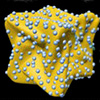| Apr 15, 2025 |
In this study, chiral gold nanoparticles with a concave vortex cube structure were employed as the chiral substrate, exhibiting highly tunable optical chirality and intriguing chiral-induced spin selectivity-like effects.
|
|
(Nanowerk Spotlight) Controlling the electron spin of oxygen-containing intermediates is crucial for efficient oxygen electrocatalysis toward clean energy technologies such as fuel cells and water electrolysis. Researchers from the College of Chemistry and Molecular Sciences at Wuhan University (WHU) recently reported a novel strategy to tune the selectivity of oxygen electrocatalysis by using chiral Au nanoparticles (NPs) as electron-spin filters. The chiral-induced spin selectivity (CISS) effect, a significant discovery in chiral spintronics, represents an alternative approach for tuning the spin selectivity of oxygen electrocatalysts.
|
|
In this study, published in Journal of the American Chemical Society (“Boosting the Selectivity in Oxygen Electrocatalysis Using Chiral Nanoparticles as Electron-Spin Filters”), chiral Au NPs with a concave vortex cube structure were employed as the chiral substrate, exhibiting highly tunable optical chirality and intriguing CISS-like effects. As model systems, the catalytically active components such as Pt or Ni(OH)2 are overgrown onto chiral Au NPs to construct the chiral hybrid electrocatalysts.
Remarkably, both cases show chirality-dependent tunable activities over oxygen reduction/evolution reactions, respectively.
|
 |
| Figure 1. Boosting the Selectivity in Oxygen Electrocatalysis using Chiral Nanoparticles as Electron-Spin Filters. (Image: © ACS)
|
|
Oxygen electrocatalytic reactions involve substantial multi-electron transfer processes and competitive interactions among various intermediate adsorbates, leading to slow reaction kinetics and high overpotentials. To overcome the above bottlenecks, pioneering works focus on selecting suitable catalytic materials and adjusting the adsorption energy of catalysts with reactants within the framework of the Sabatier principle, aiming to bring them closer to the volcano plot’s peak.
|
|
Another important strategy is to manipulate the spin states of transferred electrons during the ORR and OER. The electronic ground state of oxygen is a triplet, whereas reaction intermediates and water is in singlet states, resulting in spin-dependent characteristics for oxygen electrocatalysis reactions. Current strategies for controlling the electron spins rely mainly on tuning the chemical structure of the oxygen electrocatalyst, which is often hardly achieved for metal and oxide electrocatalysts.
|
|
R. Naaman and coworkers demonstrated that chiral molecules can serve as spin filters for electrons, enhancing transfer efficiency for a specific spin direction of electrons, known as CISS. This discovery opens a promising avenue for controlling the spin states of electrons without external fields. By modifying catalyst surfaces with chiral molecules such as DNA and peptides, it is possible to regulate electron spins, thereby affecting the efficiency and selectivity of catalytic reactions.
|
|
However, the stability and recyclability of chiral organic molecules adsorbed on the catalyst surfaces have raised some concerns regarding the instability of chirality. Thus, the rational design of robust chiral electrocatalysts with controllable electron spins toward ORR/OER remains a challenge yet to be fully addressed.
|
|
Recently, Prof. Qingfeng Zhang’s group at WHU proposed a strategy that separates the CISS-like effect from catalytically active components by using intrinsic chiral Au NPs as electron-spin filters to tune the selectivity in oxygen electrocatalytic reactions. The chiral Au VC NPs with intense optical chirality were employed as electron-spin filters, which display much better catalytic performances (higher four-electron selectivity) toward ORR than their achiral counterparts (Figure 2).
|
 |
| Figure 2. Chiral Au VC NPs as electron-spin filters for enhanced ORR performance. (Image: © ACS)
|
|
To further elucidate the CISS-like effect of chiral Au VC NPs, the team employed magnetic conductive atomic force microscopy (mc-AFM) to quantify the capability of chiral Au NPs in modulating the electron spins (Figure 3). We further took advantage of chiral Au VC NPs with tunable geometry-dependent optical chirality for correlating the chirality (g-factor) with their capability of modulating electron spins.
|
|
With the increase in g-factor values from VC-I to VC-III, chiral Au NPs exhibited lower overpotentials and higher n values, i.e. enhanced four-electron selectivity. Therefore, these results strongly demonstrated that the g-factor can be used as a descriptor for quantifying the capability of chiral NPs in modulating electron spins through CISS effect as well as enhancing ORR performances.
|
 |
| Figure 3. Correlation between chirality of chiral Au VC NPs and their capability in modulating electron spin through CISS-like effect. (Image: © ACS)
|
|
They further constructed chiral Au@Pt VC NPs for the integration of catalytically active Pt sites with chiral Au NPs as electron spin filters (Figure 4). The chiral Au@Pt nanocatalysts produce less hydrogen peroxide, leading to improved selectivity toward the four-electron pathway of ORR in comparison to achiral Au@Pt nanocatalysts without spin modulation.
|
|
These experimental results confirm the researchers’ initial hypothesis: the spin-polarized electrons modulated by the chiral Au NPs can indeed be transferred to adjacent catalytically active sites to participate in the oxygen catalytic reactions. More importantly, the modulation effect remains positively correlated with the optical chirality, which can be represented by the magnitude of the g-factor.
|
 |
| Figure 4. Chiral Au@Pt VC NPs for tunable activities toward the four-electron pathway of ORR. (Image: © ACS)
|
|
They further extended the use of chiral Au NPs as electron-spin filters to construct chiral hybrid electrocatalysts for enhanced OER (Figure 5). The chiral Au VC NPs coated with Ni(OH)₂ were observed to exhibit superior OER performance compared to their achiral counterparts, while the generation of H₂O₂ was significantly suppressed.
|
 |
| Figure 5. Construction of chiral Au@Ni(OH)2 VC NPs for enhanced OER. (Image: © ACS)
|
|
It is envisioned that this strategy can be also extended to using other optically active chiral NPs as core and other catalytically active materials as satellites for constructing high-efficiency oxygen electrocatalysts. This work also sheds light on the underlying mechanisms dictating the CISS-enhanced oxygen electrocatalysis by inorganic chiral NPs, which provides a promising perspective beyond traditional methods that tune the electron spins in oxygen electrocatalytic reactions.
|
|
Source: Provided by Wuhan University
|
|
|






